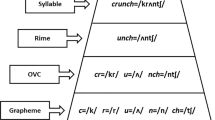Abstract
Two experiments were conducted to compare the development of orthographic representations in children learning to read English and Greek. Nonsense words that either shared both orthography and phonology at the level of the rhyme with real words (comic-bomic), phonology only (comic-bommick), or neither (dilotaff) were created for each orthography. Experiment 1 compared children’s reading of bisyllabic and trisyllabic nonsense words likebomic vs.bommick, taffodil vs.tafoddyl, and found a significant facilitatory effect of orthographic rhyme familiarity for English only. Experiment 2 compared children’s reading of trisyllabic nonsense words that either shared rhyme phonology with real words (tafoddyl) or did not (dilotaff). Significant facilitation in reading accuracy was found for shared rhyme phonology in English, with a significant speed advantage in Greek. These results are interpreted in terms of the level of phonology that is represented in the orthographic recognition units being developed by children who are learning to read more and less transparent orthographies.
Résumé
Deux études ont été réalisées afin de comparer le développement des représentations de l’orthographe chez des enfants apprenent à lire en Anglais et en Grec. On a créé des mots sans signifcation ressemblant à des mots réels soit simultanément par leur orthographe et leur phonologie (comic-bomic), soit seulement par leur phonologie (comic-bommick), ou n’ayant aucune resemblance entre eux. L’Expérience 1 a porté sur la comparaison de lecture de non-mots bisyllabiques et trisyllabiques comebomic vs.bommick, taffodil vs.tafoddyl. Un effet facilitateur de la familiarité des rimes orthographiques apparaît uniquement en Anglais. L’Expérience 2 a porté sur la comparaison de lecture de non-mots trisyllabiques ayant (taffodyl-daffodil) ou non (dilotaff-daffodil) la même rime finale qu’un mot réel. Des effets de facilitation sont apparus concernant la correction de la lecture en Anglais et la vitesse de lecture en Grec. L’interprétation de ces résultats fait intervenir le niveau de phonologie représenté dans les unités de reconnaissance orthographique des apprentis lecteurs.
Similar content being viewed by others
References
Bradley, L., & Bryant, P.E. (1983). Categorising sounds and learning to read: A causal connection.Nature, 310, 419–421.
Caravolas, M., & Bruck, M. (1993). The effect of oral and written language input on children’s phonological awareness: A cross-linguistic study.Journal of Experimental Child Psychology, 55, 1–30.
Cossu, G., Shankweiler, D., Liberman, I.Y., Katz, L., & Tola, G. (1988). Awareness of phonological segments and reading ability in Italian children.Applied Psycholinguistics, 9, 1–16.
Ehri, L.C. (1995). Phases of development in learning to read words by sight.Journal of Research in Reading, 18, 116–125.
Gombert, J.E. (1992).Metalinguistic Development. Hemel Hempstead, Herts: Havester Wheatsheaf.
Goswami, U. (1993). Towards an interactive analogy model of reading development: Decoding vowel graphemes in beginning reading.Journal of Experimental Child Psychology, 56, 443–475.
Goswami, U., Gombert, J.E., & de Barrera, F. (in press). Children’s orthographic representations and linguistic transparency: Nonsense word reading in English, French and Spanish.Journal of Applied Psycholinguistics.
Huang, H.S., & Hanley, R.J. (1995). Phonological awareness and visual skills in learning to read Chinese and EnglishCognition, 54, 73–98.
Kessler, B., & Treiman, R. (1996). Syllable structure and the distribution of phonemes in English syllables. Manuscript submitted for publication.
Lundberg, I., Olofsson, A., & Wall, S. (1980). Reading and spelling skills in the first school years predicted from phonemic awareness skills in kindergarten.Scandanavian Journal of Psychology, 21, 159–173.
Mann, V.A. (1986). Phonological awareness: The role of early reading experience.Cognition, 24, 65–92.
Naslund, J.C., & Schneider, W. (1991). Longitudinal effects of verbal ability, memory capacity and phonological awareness on reading performance.European Journal of Psychology of Education, 6, 375–392.
Naslund, J.C., Schneider, W., & van den Broek, P. (1997). Beginning reading in Germany and the U.S.: A comparison of phonological segmentation, decoding, lexical access and comprehension. In C. Hulme & R.M. Joshi (Eds.),Cross-Language Studies of Learning to Read and Spell: Phonologic and Orthographic Processing (pp. 103–120). Dordrecht, The Netherlands: Kluwer Academic Publishers.
Porpodas, C. (1993). The relation between phonemic awareness and reading and spelling of Greek words in the first school years. In M. Carretero, M. Pope, R.J. Simons, & J.I. Pozo (Eds.),Learning and Instruction (Vol. 3, pp. 203–217). Oxford: Pergamon Press.
Rack, J.P., Snowling, M.J., & Olson, R.K. (1992). The nonsense word reading deficit in developmental dyslexia: A review.Reading Research Quarterly, 27, 28–53.
Stanovich, K.E., Cunningham, A.E., & Feeman, D.J. (1984). Intelligence, cognitive skills and early reading progress.Reading Research Quarterly, 19, 278–303.
Thorstad, G. (1991). The effect of orthography in the acquisition of literacy skills.British Journal of Psychology, 82, 527–537.
Treiman, R. (1988). The internal structure of the syllable. In G. Carlson & M. Tanenhaus (Eds.),Linguistic structure in language processing (pp. 27–52). Dordrecht, The Netherlands: Kluger.
Treiman, R., & Hirsh-Pasek, C. (1985). Are there qualitative differences between dyslexic and normal readers?Memory and Cognition, 13, 357–364.
Treiman, R., Mullennix, J., Bijeljac-Babic, R., & Richmond-Welty, E.D. (1995). The special role of rimes in the description, use and acquisition of English orthography.Journal of Experimental Psychology, General, 124, 107–136.
Wimmer, H. (1993). Characteristics of developmental dyslexia in a regular writing system.Applied Psycholinguistics, 14, 1–33.
Wimmer, H. (1995). From the perspective of a more regular orthography.Issues in Education, 1, 101–104.
Wimmer, H., & Frith, U. (1993).Orthographies and learning to read: An English-German comparison. Unpublished manuscript, University of Salzburg.
Wimmer, H., & Goswami, U. (1994). The influence of orthographic consistency on reading development: Word recognition in English and German children.Cognition, 51, 91–103.
Wimmer, H., Landerl, K., Linortner, R., & Hummer, P. (1991). The relationship of phonemic awareness to reading acquisition: More consequence than precondition but still important.Cognition, 40, 219–249.
Wimmer, H., Landerl, K., & Schneider, W. (1994). The role of rhyme awareness in learning to read a regular orthography.British Journal of Developmental Psychology, 12, 469–484.
Author information
Authors and Affiliations
Rights and permissions
About this article
Cite this article
Goswami, U., Porpodas, C. & Wheelwright, S. Children’s orthographic representations in English and Greek. Eur J Psychol Educ 12, 273–292 (1997). https://doi.org/10.1007/BF03172876
Received:
Revised:
Issue Date:
DOI: https://doi.org/10.1007/BF03172876




